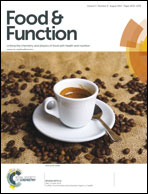Hypolipidemic activity of Taraxacum mongolicum associated with the activation of AMP-activated protein kinase in human HepG2 cells†
Abstract
This study investigated the hypolipidemic effect and potential mechanisms of T. mongolicum extracts. T. mongolicum was extracted by refluxing three times with water (TM-1), 50% ethanol (TM-2) and 95% ethanol (TM-3). TM-2 contained components with the most effective hypolipidemic potentials in HepG2 cells. Extended administration of TM-2 stimulated a significant reduction in body weight and levels of serum triglyceride LDL-C and total cholesterol in rats. To evaluate the bioactive compounds, we successively fractionated TM-2 with n-hexane (TM-4), dichloromethane (TM-5), ethyl acetate (TM-6), and water (TM-7). TM-4 fraction had the most effective hypolipidemic potential in HepG2 cells, and it decreased the expression of fatty acid synthase (FASN) and inhibited the activity of acetyl-coenzyme A carboxylase (ACC) through the phosphorylation of AMP-activated protein kinase (AMPK). Linoleic acid, phytol and tetracosanol are bioactive compounds identified from TM-4. These results suggest that T. mongolicum is expected to be useful for hypolipidemic effects.


 Please wait while we load your content...
Please wait while we load your content...